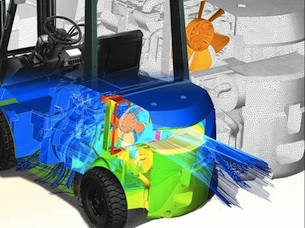June 21, 2010
By Yuya Ando, Software Cradle
 When computational fluid dynamics (CFD) predictions dont agree with well-controlled experimental measurements, are the differences due to:
When computational fluid dynamics (CFD) predictions dont agree with well-controlled experimental measurements, are the differences due to:
1. An inaccurate CFD solver (physical models, algorithms, numerical diffusion, or truncation errors) that are largely outside the users control? or
2. Faulty human inputs (poor geometry representation, low mesh quality, inaccurate material properties and/or boundary conditions), which can be minimized by improved user training and experience?
In reality, CFD accuracy is affected by both. However, a colleague with more than 20 years of industrial CFD experience once told me that when he has problems with CFD, 95% of the time the problem is with the mesh. The quality of the CFD mesh is not just a product of the grid generation software. It is a product of both the mesh generator in the pre-processor and the solver because each is an enabler for what the user can do.
Good CFD software gives the user maximum control of the grid. Good CFD software also has low memory consumption enabling the user to run larger models that maximize grid resolution where needed. Software Cradle, developer and supplier of SC/Tetra, its flagship multi-purpose, unstructured grid CFD software product, cites several features in SC/Tetra that help minimize user induced errors and enable creation of accurate CFD simulations:
- Geometry diagnostics and repair capabilities integrated within the pre-processor along with wrapper functionality for eliminating CAD artifacts (e.g. small edges, gaps, and overlaps), simplifying the geometry, and creating an accurate, high-quality geometrical representations suitable for CFD modeling.
- Fast and robust octree-based mesher that provides control of the mesh within the computational domain (versus only controlling the mesh on the geometry surfaces). In one hour, a 15 million element model with two prism layers on the surfaces can be generated using a Windows XP x64 PC with 4GB RAM.
- Flexible manual control of the mesh or automatic mesh refinement in regions with high gradients.
- Rotational or linear moving mesh with overset mesh capabilities for eliminating stretching and/or shrinking meshes.
- Low memory consumption solver (5M cells/GB of RAM) that enables running larger, higher resolution models and/or more geometrically complex models. This can be important for small/medium sized companies that dont have access to large super computers.
- Sophisticated physical models for simulating complex physical phenomena, including 10 turbulence models, free surfaces, cavitation, and fully coupled human body thermoregulation.
Subscribe to our FREE magazine, FREE email newsletters or both!
About the Author
DE’s editors contribute news and new product announcements to Digital Engineering.
Press releases may be sent to them via [email protected].






